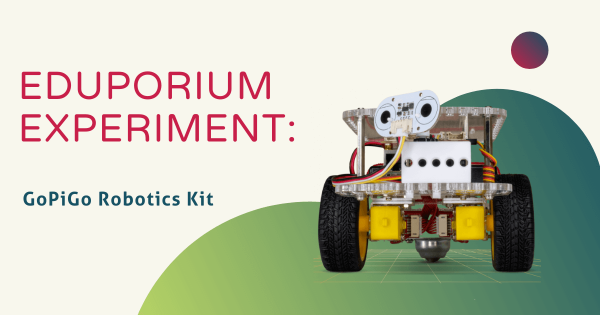In this week’s Eduporium Experiment, we are taking a deeper look at Stikbot and its potential to enrich hands-on education in the early grades. Besides being an entertaining, posable toy that allows kids to use stop motion animation anywhere, it’s also a great way for them to learn to work in small groups, problem solve, and more.
Eduporium Experiment
Our Eduporium Experiment series is one of our longest running blogs. Whenever we add new STEAM solutions to our store, we try it out so we can learn all about it. Over the years, we've covered dozens of top STEAM teaching tools, offering our first-hand insights and tidbits for educators. We believe this content gives K–12 teachers valuable information when it comes to using various STEAM solutions with their students. Our team analyzes products from different points of view and even considers implementation strategies in different educational environments. Whether it's most useful in the makerspace, library, or in the general classroom, we're happy to continue providing these helpful guides. You'll even find classroom-ready STEAM projects to try with your students. Browse through the posts or use the search bar on the left to find exactly what you're looking for.
In each 'experiment,' we provide key background information on the STEAM tool being featured. From there, we explore an actual project. This allows us to discover subtle tricks and hints that are extremely helpful for educators to know. Whether it's a coding tool, educational robotics solution, or even an engineering kit, we do our best to cover everything educators are investigating. As the Eduporium Experiment series has expanded, we've come a pretty long way. Now, you can find dozens of helpful articles that may include step-by-step project guides, troubleshooting suggestions, and even our thoughts on what makes each STEAM tool worthwhile for 21st century students. Find our insights on integrating STEM tools like the Bee–Bot, Finch 2.0, Ozobot Evo, micro:bit V2, and so many more!
-
Eduporium Experiment | MakeDo ToolKit
Kids today don’t seem to have the same enthusiasm to build a pillow fort or make costumes out of cardboard. Instead, it is all too common to see them playing with a smart device, but, the line of inventive kits from MakeDo aim to spark creativity in kids by facilitating hands-on building and engaging them with something other than technology. -
Eduporium Experiment | The Dot Robot From Wonder Workshop
If you’ve heard of the Dash Robot from Wonder Workshop, you’ve most likely heard of the Dot! Small but mighty, the Dot is a responsive and interactive robot designed for students aged six and up. Though it may not be quite as popular as the Dash because it lacks its own motors, the Dot is still a great tool for -
Eduporium Experiment | Marbotic Pt. 2
Essentially, the premise of Marbotic is providing preschool teachers with a technology tool that engages students, allows for physical interaction, introduces letters and numbers, and helps build their foundational tech skills. You can probably see why we’re such big fans of this system and how it allows for tactile learning at such a young age! -
Eduporium Experiment | GoPiGo Robotics Kit
The GoPiGo build-your-own robotics kits are top of the line. They are powered by a Raspberry Pi and come in wide ranges of sizes to fit all needs and accommodate various classroom setups. The Base Kit is the smallest and perfect for any students who have used a Raspberry Pi, whereas the Starter Kit is for those who want to -
Eduporium Experiment | SAM Labs Curious Cars Kit
The Curious Cars kit in particular comes with six pieces of technology, all very uniform in size, and all encased in soft, malleable plastic. They are clearly labeled in simple language, and the whole kit is very fun to touch, which is designed to be encouraging for learners and get them started with getting their hands on the technology. -
Eduporium Experiment | Bloxels Pt. 2
Bloxels is in a field of its own. Why? It empowers students as young as five years old to try their hand at video game design. Seriously, students from grades K-8 can build an entire video game from scratch with Bloxels’ blocks and gameboard! It’s a totally hands-on experience during which students use the different blocks to design layouts and -
Eduporium Experiment | Hummingbird Robotics Kits
Covering engineering, arts, programming, and robotics, Hummingbird is a true STEAM experience as it combines technology and robotics with artistic creativity. Students use the kit’s components, including LEDs, motors, sensors, servos, and craft materials to build a functional robot that they can program in various languages. -
Eduporium Experiment | Edison Robot EdCreate Kit
The EdCreate Kit is something all STEM teachers should be looking to add to their classrooms. It’s pretty much guaranteed to inflate students’ skills as they expand on Edison’s build with 115 interlocking parts they can use to create five exciting, new robots. The EdTank, EdDigger, EdRoboClaw, EdCrane, and EdPrinter. -
Eduporium Experiment | The Ollie Robot
We know that there might be a lot of teachers who believe that children are experienced with SPRK+ and want the next best thing. Well, the Ollie robot can flip, spin, and perform combinations of tricks to keep all your students engaged! Programmable and drivable just like the SPRK+, the Ollie model can also help students take their robotics skills













